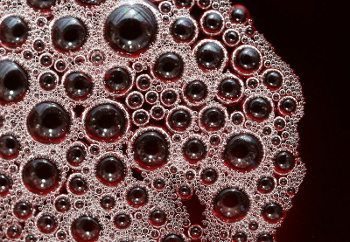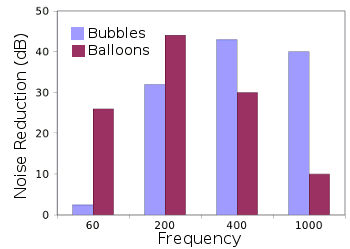Bubble Noise Reduction
June 7, 2011
There are quite a few similarities between
optics and
acoustics. In optics, when a light ray reaches an interface between media of two different
refractive indices, part of the ray is transmitted, and part is
reflected. There's a
simple equation that gives the fraction of light reflected
R
R = [(n1 - n2)/(n1 + n2)]2
where
n1 is the source medium of the light ray, and
n2 is the medium that it's entering.
You can reduce the reflection by putting an intermediate layer of refractive index (n
1⋅n
2)
1/2 between the two media. For example, the reflection of
window glass (n = 1.5) can be reduced with a layer of n = 1.225, since air has a refractive index of 1.0. An old
electrical engineer told me that this is just
impedance matching applied to optics.
Acoustical reflection acts similarly, except the important factor is not refractive index difference, but the difference in the product of the
speed of sound v and
density ρ. This product is the
acoustic impedance Z of the material
Z = ρv
If we assume that the sound waves are much smaller in
wavelength than the size of the acoustical material, just like the wavelength of light is much smaller than a piece of window glass, we can calculate the reflectance,
R = (Z2 - Z1)/(Z2 + Z1)
Since the acoustic impedance of
water is more than 3,000 times that of
air, air bubbles in water will reflect nearly all sound, inverting the
phase; that's because R ≈ -1. A wall of bubbles will block sound from the other side, provided, however, that the size of the bubble is at least as large as the wavelength as the sound wave.

Nature imitating art.
Photograph by Friedrich Böhringer, via Wikimedia Commons)
Since the speed of sound in water is about 1500
m/s at 25 °C, the wavelength of a 1500 Hz tone is a
meter. It's quite unlikely that you'll find a one meter air bubble underwater, but you could immerse large
balloons for the same effect. If you have more bubbles than just a single sheet, you can still get appreciable attenuation even when there's a large mismatch of size and wavelength.
Man-made underwater noise has a disruptive effect on
marine life. It's
well known that
whales communicate using sound; and unusual, or masking, sounds can affect the
migratory patterns of marine mammals. Bubbles could be an inexpensive means to reduce the sound level of such intense sound sources as
pile-driving.
In one experiment, bubbles were used to minimize the underwater sound of a pile-driver in 6-8-meter waters west of
Hong Kong.[1] A perforated rubber hose created a bubble curtain around the pile-driver that reduced broadband noise by 3-5
dB. The bubble curtain produced the greatest sound reduction in the frequency range, 400-6400
Hz.
A research group from the
Applied Research Laboratories and the
Mechanical Engineering Department at the
University of Texas at Austin presented a paper on May 24, 2011, at the
161st Meeting of the
Acoustical Society of America that addresses the sound attenuation of bubbles in water. To produce large bubbles, as well as small, they used tethered balloons. They investigated a particular energy loss mechanism that supplements the reflection effect.
Acoustic noise will excite a
volumetric oscillation of a bubble in which the bubble will shrink and expand. This is expected, since sound is an alternating
pressure. Bubbles will have a
resonant frequency that's an inverse function of its size. Near the water surface, a 1 mm radius bubble will resonate at 3000 Hz, and a 50 mm radius bubble will resonate at 60 Hz. This is quite a bit smaller than the meter sizes required for reflection.

A graphical summary of the University of Texas at Austin underwater noise reduction experiment.[2] Tethered balloons are effective at low frequencies, and bubbles are effective at higher frequencies.
Plot via Gnumeric
As can be seen from their data, the tethered balloons are effective at low frequencies, and bubbles are effective at higher frequencies, so there's considerable noise reduction over a wide band of frequencies.
References:
- B. Würsig, C.R. Greene Jr. and T.A. Jefferson, "Development of an air bubble curtain to reduce underwater noise of percussive piling," Marine Environmental Research, vol. 49, no. 1 (February,2000), pp. 79-93
- Kevin M. Lee, Kevin T. Hinojosa, Mark S. Wochner. Theodore F. Argo IV and Preston S. Wilson, "Using bubbles to reduce underwater noise," Paper 2aUWb11 of the 161st Meeting of the Acoustical Society of America, May 24, 2011.
Permanent Link to this article
Linked Keywords: Optics; acoustics; refractive index; reflection; window glass; electrical engineer; impedance matching; acoustical reflection; speed of sound; density; acoustic impedance; wavelength; water; air; phase; Wikimedia Commons; m/s; meter; balloon; marine life; Star Trek IV: The Voyage Home; whale; migratory pattern; pile-driving; Hong Kong; decibel; dB; Hz; Applied Research Laboratories; Mechanical Engineering Department; University of Texas at Austin; 161st Meeting; Acoustical Society of America; volumetric oscillation; pressure; resonant frequency; Gnumeric.